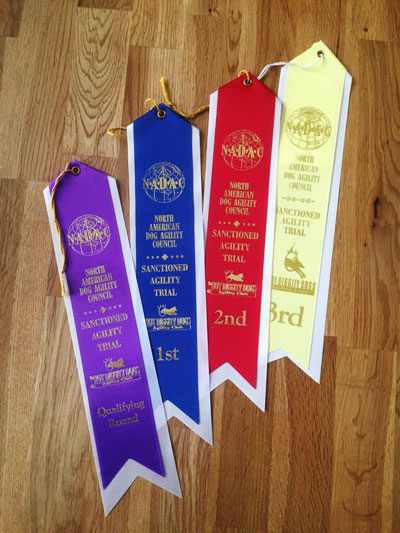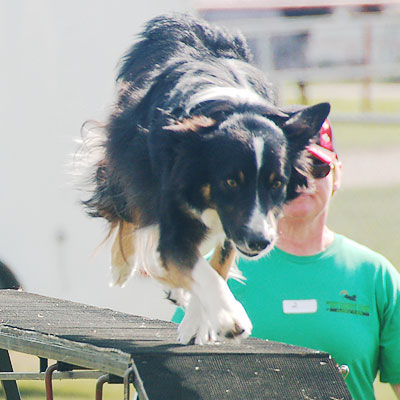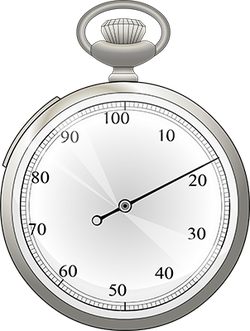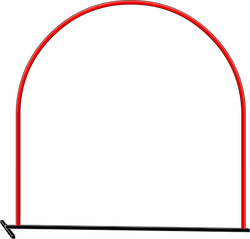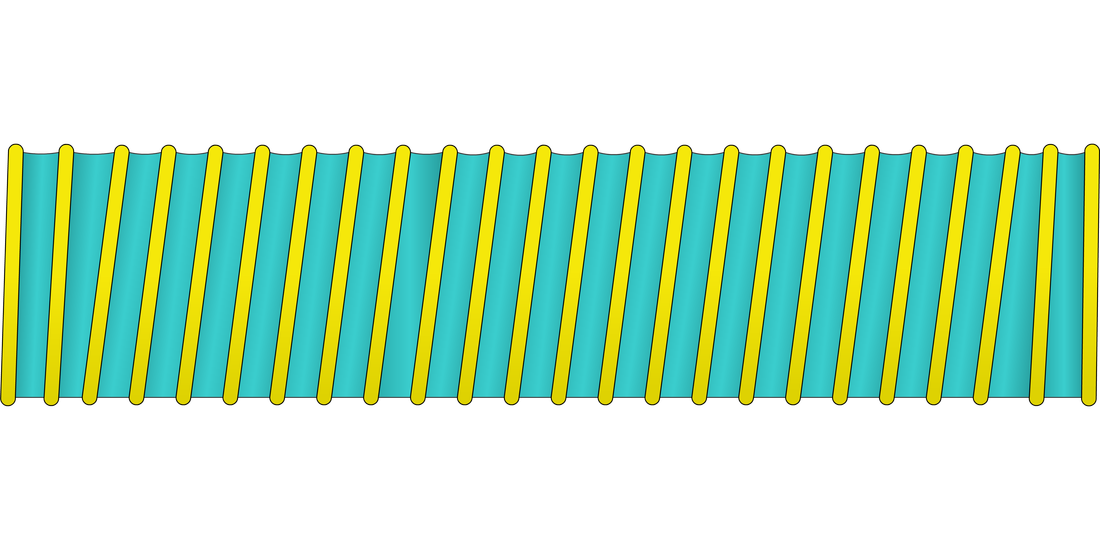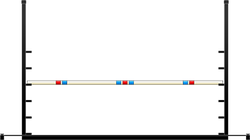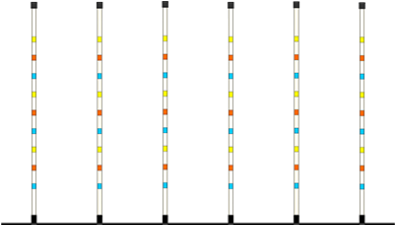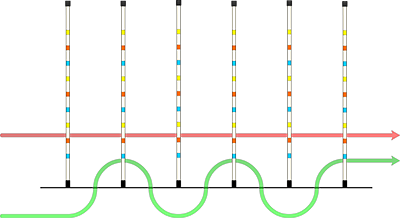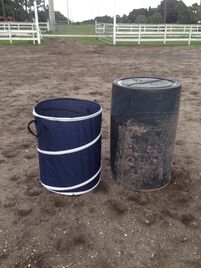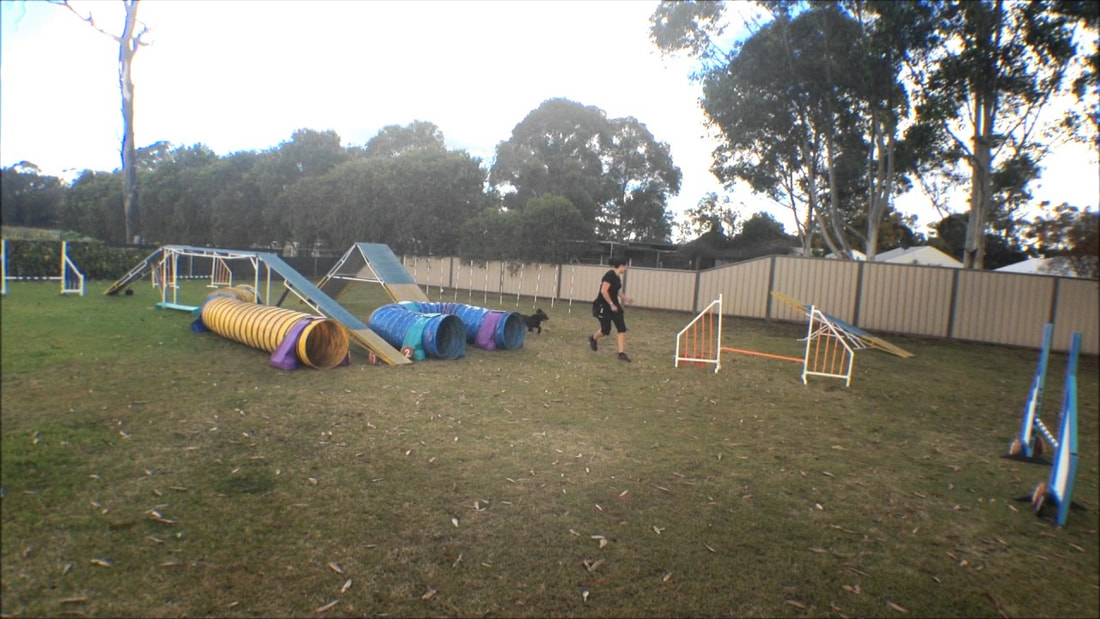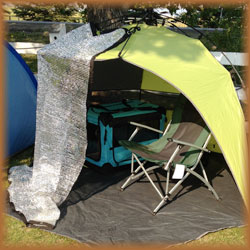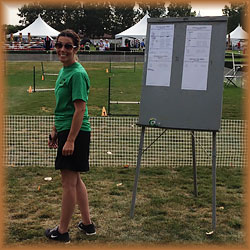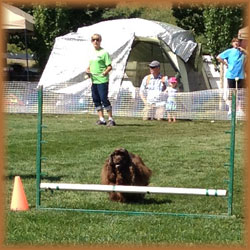|
"N's" and "E's"are bumps on the road towards Q's. An N indicates a Non-Qualifying Run, which is what happens when you and your dog:
|
An E stands for Eliminated. This can happen for a variety of reasons, including:
|
PlacementPlacement refers to ranking - first, second, third, etc. This is where dogs are actually competing against other dogs. You can take an N in a class, but still nab first place, if no one managed a Q. However, if you get an E, you will not place for that class at all. One of the great things about NADAC agility is that it's open to every dog, regardless of pedigree. But in practice, how on earth do you fairly score a St. Bernard, a border collie, and a chihuahua, all of whom just ran the same course? Answer: You don't. Or, at least, you don't score them against each other. Placement is divided by jump height categories, so that dogs will be competing (roughly) against their own size. Jump height is declared when registering for the trial, and is carried to all classes, even when there are no jumps in that class. This will determine your dog's place in the running order, and the peer group that they will compete with for placement. |
JumpsJumps are similar to hoops and tunnels; on course you must pass through every marked jump, and in the correct direction. In addition, points will be deducted for any jumps knocked down, or jump standards knocked over. Courses often loop through obstacles; you may see the same jump multiple times during your run. So what happens if you knock the bar down? (Hey, it happens!) You will continue through the course, and your dog should treat the jump uprights as a hoop to run through if it is encountered again. |
Weave PolesWeave poles begin in sets of 6, but as you move up levels, they will start to appear in sets of 12. To complete weave poles successfully, your dog must enter with the first pole on his left hand side. On- and Off-side WeavingWhen you are on the same side of the weave poles as your dog, it's called on-side weaving. If the weave poles are between you and your dog, it's called off-side weaving. Both are legitimate ways to get through the weaves, and you'll need to practice both approaches. Whichever side of the weaves you are on, though, your dog must still enter and weave correctly, with the first pole on his left. |
On-Side Weave |
Off-Side Weave |
The green arrow is the dog's path through the weaves. The red arrow indicates the handler's path. Notice that the dog's path doesn't change, even when the handler is on the opposite side. Both of these examples are correct ways to complete the weaves.
Because the weaves can be difficult, you get three chances to do them correctly, without penalty. If your dog misses her entrance, or pops out after completing a couple of weaves, you can circle back and try again. When you circle around, your dog must NOT take any other elements, or do any weaving in the wrong direction while returning to the start of the poles. You can then address the weaves again. (Note that even if your dog had completed a few of the weaves properly on your first attempt, you must start at the beginning on your next attempt, and go through the complete set).
If your dog misses a weave partway through the set, but continues weaving through the rest, you may not try again.
Contact ObstaclesThe A-Frame (A.K.A. the Wall), and the Dogwalk (A.K.A. the Bridge) are Contact Obstacles. They have a contact zone marked at each end. Your dog must put a paw (or at least a nail!) into the contact zone as they descend. This is enforced for safety reasons; both pieces of contact equipment are high enough that a dog could be injured if they jump from the top. You will see that some handlers ask for a pause at the very bottom of the contact zone, even in a trial. This is to guarantee that the dog will touch that zone, and not leap over it. This pause is not required; other dogs may be allowed by their handlers to leave the equipment immediately. |
Gates
Dogs will be required to pass a gate, either on the near side, or the far side, as indicated by the course design. They will need to pay attention to you as their handler for the correct cue; there will be nothing inherent in the course design to help them understand which will be correct.
You'll see gates in the extreme games, both in gators and hoopers classes.
BarrelsA barrel is similar to a gate in that it can be passed on the near or far side, depending on the course design. Occasionally, the pylon will be in the middle of the barrel, which indicates that it doesn't matter. This is more common in lower levels. You'll see barrels in the extreme games barrellers class. |
DiscriminationA discrimination is a situation presented by the course design, where two elements look equally enticing to the dog. A really common discrimination is a tunnel set right beside the bridge. It won't take long before you discover that your dog really likes one over the other, and you'll need to learn to communicate with him about which element he is supposed to choose at that moment. |
Entering a Trial
Entering your first trial can be intimidating, but we'll walk you through it!
The Premium
The paperwork that you'll need to fill out is called the trial premium. The premium should have all of the information that you'll need, including:
- The time, date, and location of the trial
- The presiding judge
- The classes offered
- The cost
- Any special instructions competitors might need
What Can I Enter?
The short answer? Anything class you want! Classes are run one at a time, so you don't need to worry that you might be signing up for two overlapping events. However, most trials will not allow you to enter the same dog into the same class, at two different levels. So, in a single day, you probably can't enter Rover in Jumpers (Intro) and Jumpers (Novice). But you can enter Jumpers (intro), Regular (Novice), Weavers (Open) and Touch 'n Go (Elite).
You probably won't see every event offered at every trial. This can make completing titles an adventure; you might need to travel to get that last tunneler's class in!
Junior, Standard or Veteran Division?
Division makes a difference in time allowed, and may make a difference in placement (first, second, third place, etc).
You'll need to declare your division, as Junior, Standard or Veteran/Disabled. (Many premiums don't explicitly state "standard"; you'll be standard by default if you don't indicate that you are a junior or veteran/disabled handler.) You will run the same course as everyone else in that class. (E.G., all teams entered in Jumpers (Novice) will run the same course, fitting into the same running order regardless of their division.) In fact, it won't be obvious to anyone watching that there may be different divisions at all! It will only become apparent on the results sheet. Junior and veteran/disabled teams will be given a little more time on course, and, depending on the class, they may have their own placements. In that Jumpers (Novice) class mentioned above, we might see three different first places awarded to a single height, if there were three different divisions entered into it!
You'll see discussion of "jumping" and "non-jumping" classes here. Jumping classes refer to classes where you'll encounter jumps: Regular, Jumpers, and Chances. All other classes fall under the category of non-jumping classes.
Junior Handler
If you are 17 years old or less, you are a junior handler. The junior handler division only applies to jumping classes. In these courses, there will be a junior handler time specified, and junior handler teams will be placed separately from standard and veteran teams.
Veteran (Dog)
If your dog is 7 or older, you can enter her as a veteran in the jumping classes. This means that your dog will be given more time to complete the course, and will be placed separately from the other divisions. The veteran designation for dogs is not given for non-jumping classes.
Note that in spite of the name, "veteran," your dog's qualification for this division is based purely on their age. They are NOT required to have competed in the past in a standard division to obtain veteran status.
Veteran or Disabled (Handler)
If you as a handler are 60 or over, or if you have a certificate of disability, you may enter the trial as a veteran/disabled handler. This designation applies to the entire trial; all classes, and all dogs that you handle will compete with the veteran/disability designation. The Veteran/Disabled Handler division gives your dog a little extra time on course to account for mobility issues. In jumping classes, your dog will be placed with veteran dogs. In non-jumping classes, your dog will be placed with the standard division.
So What's My Dog's Jump Height?
Jump height is the next question you will face. Jump height is determined by your dog's height at the withers (front shoulder blades, measured while they are standing).
The proficient divisions are:
But it doesn't end here! This is the highest your dog is allowed to jump in NADAC, but it may just the starting point for figuring out your where you will jump. If your dog is a veteran dog, or if you are a veteran/disabled handler, or a junior handler, your dog is allowed to jump 4" lower than their measured height category. If you qualify for a breed exemption, you may also reduce your jump height by 4". (Check the NADAC regulations here to see if your dog qualifies. ). And now we get to the question of skilled vs. proficient.
Skilled or Proficient?
Dogs jumping in the skilled category are allowed to jump 4" lower than their proficient jump height. The decision to enter skilled vs. proficient can be a matter of opinion; many people will have thoughts on which you should enter, and why. At the end of the day, however, there is no difference between the two categories other than the lowered jump height.The Classes
Regular
Regular has a little of everything. Expect to handle your dog through hoops, jumps, tunnels, weaves, the wall, and the bridge! While gates and barrels are coming into NADAC, at this time they haven't shown up in regular courses yet.
Intro
You won't see weaves in Intro
Novice
May or may not include 6 weaves
Open
Will include 6 weaves, which may be encountered more than once in the course. May include discriminations.
Elite
Will include sets of 12 weaves, which may be encountered multiple times in the course. Discriminations are likely.
Jumpers
Jumpers courses are made up primarily of jumps, but they might also include a tunnel. Expect to loop through jumps several times; particularly if you are in the higher levels.
Intro
Approximately 10 elements
Novice
Approximately 15 elements
Open
Approximately 20 elements
Elite
Approximately 25 elements
Chances
Chances looks like a regular agility course, and you can expect to handle any of the elements that you would normally see in regular at your level. However, chances brings one more twist; the chances line. This is the line made with flagging tape that the handler can't cross during the run. Dogs, of course, can cross the line freely.
Chances, as well as Touch 'n' Go, and Tunnellers, uses the same elements for Novice, Open and Elite. Unlike the other two courses, though, the line is moved between classes, with the fewest challenges beyond the tape for Novice.
Special Rules and Penalties
- Crossing the chances line:
- Elimination
Benching(For the uninitiated, benching covers setting up your kennel, and staking your claim to a little bit of space for the duration of your stay at that trial.) Read your premium carefully! The trial secretary may have put some special information in about benching, such as when it will begin, the general area where it will take place, and/or any facility rules that you should be aware of. Packing List IdeasEveryone has a different packing list, but here are a few ideas to get you started. The basics
|
A sweet spot to bench at an outdoor trial |
Indoor Trial
|
Outdoor Trial
|
What NOT to bring
Please, leave the squeaky toys at home. You will be very, very unpopular if you distract a dog during a competition run!
|
One of our club members, being awesome and volunteering as a gate steward |
Volunteer!The best way to learn the ins and outs of trials is to get involved! Trials need a lot of volunteers to run smoothly, so when you arrive, have a look around for the volunteer board. Each class will need a scribe, a timer, a gate steward, and a leash runner, and almost all of the classes will need several pole setters as well. Try signing up for leash running, or for pole setting to start. Don't be afraid to let other volunteers know that you're new; they'll help you out if you need it. |
Pole SetterPole setting is one of the easiest jobs to learn. You'll sit or stand in a designated space, and when a height change is called, you'll move the bar on all of the jumps near you. If a dog knocks a bar down, you'll reset it, after that dog has finished with that area of the course. |
Extra Perk: Pole setters often get the best view of the class! |
|
This dog is clearly not a trustworthy leash runner. It's far better for people to volunteer. |
Leash RunnerLeash runner is another job that is very easy to learn. After each team starts, you'll pick up their leash, carry it to the finish area, and hand it to the handler. You may occasionally get specific instructions from the handler, such as, "On the post", or "On the ground, please." (They are asking you to place their leash on the post by the ring gate, or on the ground at the finish area.) This is the only job that will require you to move around on the course (or, near the course) while dogs are competing. Use common sense to and do your best to be respectful of the competing team while doing your job. |
Been There, Done That...
Tips from experienced club members
Jodi says, "Something no one ever told me was the dogs run "naked." This means they cannot compete wearing a collar. (This is done for safety reasons, to make sure they don't snag their collar on any equipment while they run.)"
Robyn says, "I didn't know that as a handler, I should attend the judge's briefing. I thought it was just for judges!"
